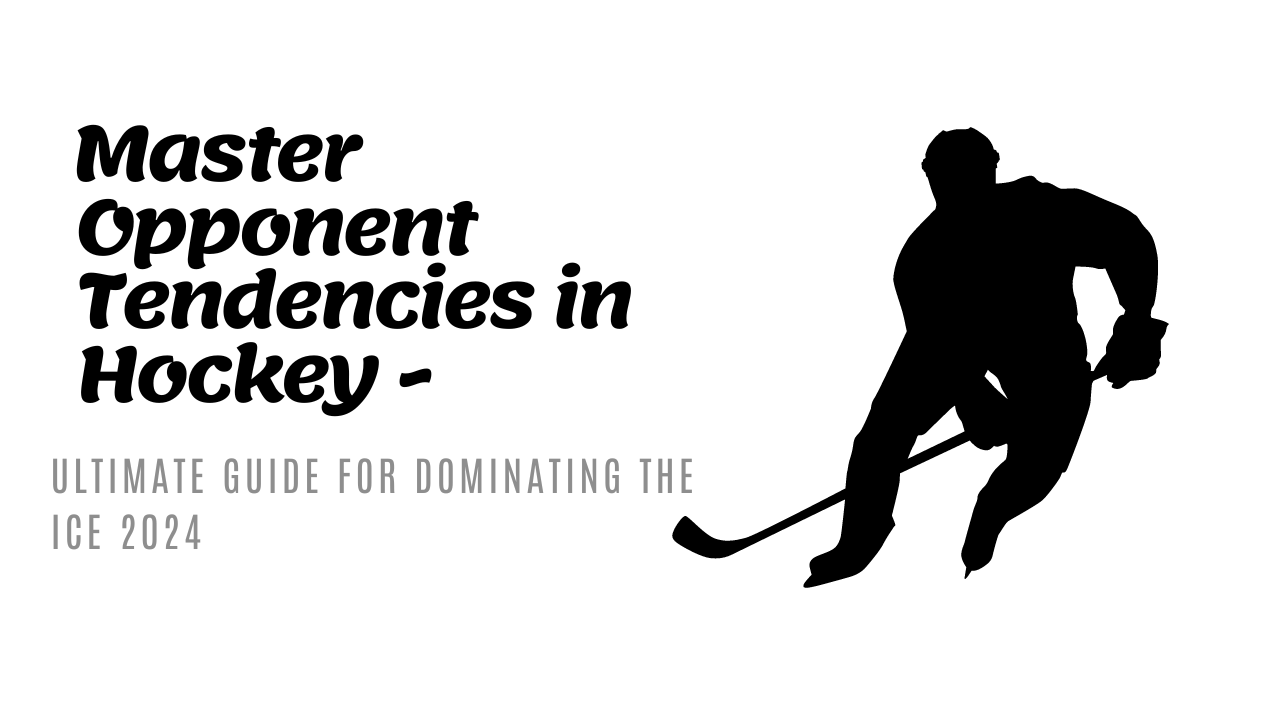Ever wonder what separates good hockey players from great ones? It’s their ability to anticipate the opponent’s next move. Understanding opponent tendencies is crucial in gaining a competitive edge. By knowing how your rivals play, you can make better decisions, react faster, and ultimately outsmart them on the ice.
In this post, you’ll discover key techniques and strategies for scouting opponents. You’ll learn how to read the game, identify patterns, and use this knowledge to sharpen your gameplay. If you’re ready to take your skills to the next level, this guide is for you. Let’s dive in and make your game-winning moves unstoppable.
Why Scouting Opponent Tendencies is Crucial
Understanding your opponent’s tendencies is an essential part of any competitive sport, and hockey is no exception. By recognizing patterns in an opponent’s gameplay, you can significantly enhance your team’s performance and strategy.
Gaining a Competitive Edge
When you understand your opponent’s tendencies, you can predict their moves and make better decisions on the ice.
 Photo by Patrick Case
Photo by Patrick Case
Knowing your rivals’ favorite strategies allows you to:
- Anticipate Plays: You’ll be able to read the game better, knowing when they’re likely to make a particular move. This can help you be in the right place at the right time.
- React Faster: Quick reaction time is crucial in hockey. By predicting your opponent’s actions, you can react more swiftly, giving you a clear advantage.
- Outsmart Your Opponent: Knowing what your opponent is likely to do next lets you plan your moves more effectively, outmaneuvering them.
For instance, if you notice a forward who frequently takes slap shots from the left circle, you can position your defense accordingly to block their shots and turn the play into an opportunity for a counter-attack.
Improving Team Strategy
Coaches can use information about opponent tendencies to refine their game plans and training sessions.
Here’s how:
- Tailored Game Plans: By knowing the strengths and weaknesses of the opposing team, coaches can devise a game plan that either exploits their weaknesses or neutralizes their strengths. For example, if an opponent has a weak penalty kill, your coach might focus on power play strategies during practice.
- Targeted Training: Specific training drills can be designed to prepare for particular opponents. If a team is known for aggressive forechecking, you can practice breaking out of the defensive zone under pressure.
- Player Matchups: Coaches can strategize player matchups more effectively. They might choose to put a strong defensive line against an opponent’s top offensive line to minimize scoring chances.
By incorporating these tactics into your team’s regular practice, you not only prepare for specific games but also improve overall team cohesion and performance.
Scouting opponent tendencies allows teams to stay one step ahead, transforming potential weaknesses into strengths and creating opportunities where none seemed to exist. In hockey, where seconds matter, this knowledge can be the difference between winning and losing.
Techniques for Scouting Opponent Tendencies
Scouting opponent tendencies is crucial for sharpening your gameplay and giving your team an edge. By analyzing various aspects of your opponent’s play, you can identify strengths and weaknesses, and make more strategic decisions on the ice. Here are some effective techniques to scout opponent tendencies.
Video Analysis
 Photo by Andrea Piacquadio
Photo by Andrea Piacquadio
Using game footage to scout opponents is one of the most powerful tools in a hockey player’s arsenal. With video analysis, you can break down every aspect of an opponent’s game.
- Spot Patterns: Watch for recurring plays and strategies. Does the opponent always pass to a specific player when in a pinch? Do they favor a certain side of the ice for their attacks?
- Evaluate Player Tendencies: Focus on individual players to understand their habits. For example, a player might always deke to their backhand on breakaways.
- Team Dynamics: Notice how the team functions as a unit. Are their lines synchronized? Do they prefer quick transitions or controlled breakouts?
Taking notes on these observations and reviewing them before games can help you anticipate and react more effectively on the ice.
Statistical Analysis
Statistics are more than just numbers; they give you concrete data to understand your opponent’s gameplay. Here are key metrics to consider:
- Scoring Chances: How frequently does the opposing team get high-danger scoring opportunities?
- Power Play and Penalty Kill: What are their success rates? A team with a weak penalty kill can be exploited via power play strategies.
- Possession Metrics: Stats like Corsi or Fenwick can reveal how well a team controls the puck. A high Corsi percentage indicates strong puck possession and could mean a tougher game.
By analyzing these stats, you can pinpoint where your opponents excel or struggle, allowing you to tailor your strategies accordingly. Sites like Natural Stat Trick provide detailed hockey statistics that can be very useful.
On-Ice Observation
There’s no substitute for watching your opponents live. Observing them during warm-ups and games can offer insights that video and stats might miss.
- Watch Warm-ups: These are great for observing individual player skills and tendencies. Notice how players shoot, pass, and maneuver during these less pressured moments.
- Observe During Games: Pay attention to their style of play and how they respond under stress. Do they crumble under aggressive forechecking? Is their goalie weak on low shots?
Personal observation allows you to catch nuances and subtle habits that aren’t easily quantifiable but make a significant difference during the game.
Each of these techniques—whether through video, stats, or live observation—provides a piece of the puzzle that can help you better understand and anticipate your opponent’s moves. Incorporating these methods into your preparation can give you a significant competitive advantage.
Key Areas to Focus On
Understanding opponent tendencies is about spotting patterns in their gameplay. Success in this area will allow you to make smarter decisions and take your game to the next level. Here are three crucial areas to focus on when scouting your opponents: offensive patterns, defensive setups, and special teams.
Offensive Patterns
To counteract offensive strategies, you need to identify them first. This can be done by watching game footage and noting specific behaviors and trends in the opponent’s offensive play.
 Photo by Pixabay
Photo by Pixabay
Here are some key aspects to watch for:
- Preferred Attack Zones: Does the team favor attacking from specific areas of the ice? For example, some teams might frequently set up plays from the corners or behind the net.
- Player Roles: Identify who the playmakers and scorers are. This helps you know which players to watch more closely.
- Passing Patterns: Notice if they rely on quick, short passes or long, stretch passes to move the puck.
- Entry Strategies: See how they enter the offensive zone. Do they carry the puck in or dump and chase?
By understanding these patterns, you can position your defense to cut off their favorite plays and force them into uncomfortable situations.
Defensive Setups
Recognizing and exploiting weaknesses in an opponent’s defensive formation can turn the tide in your favor. Start by examining how they set up defensively.
- Defensive Zone Coverage: Pay attention to whether they use man-to-man or zone coverage. This will help you decide how to break through their setups.
- Gap Control: Notice how close they stay to attackers. Teams with poor gap control can be exploited with quick passes and fast skating.
- Breakout Strategies: Understand how they transition from defense to offense. Do they use set plays or rely on individual skill to exit their zone?
For example, if a team has a hard time handling aggressive forechecking, you can apply more pressure on their defensemen, forcing turnovers and creating scoring chances.
Special Teams
Special teams—power plays and penalty kills—are crucial areas where games can be won or lost. Understanding these aspects can give you a huge edge.
- Power Play Tendencies: Look at how the opponent sets up their power play. Do they use a 1-3-1 formation, or do they prefer an umbrella setup? Knowing this can help you anticipate their movements and make timely interventions.
- Penalty Kill Strategies: Are they aggressive with their penalty kill, applying pressure on puck carriers, or do they sit back in a passive box or diamond formation?
Identifying these patterns allows your team to adapt and exploit weaknesses. For instance, if an opponent has a passive penalty kill, you can take more time to set up high-quality scoring chances.
By focusing on these key areas—offensive patterns, defensive setups, and special teams—you’ll be in a better position to anticipate your opponent’s next move and adjust your strategy accordingly. Knowledge is power, and the more you know about your opponent, the more control you have over the game.
Case Studies and Examples
Scouting opponent tendencies isn’t just for professional teams. It benefits players and coaches at every level of hockey, from the NHL to youth leagues. Let’s look at how different levels of hockey use scouting reports to prepare for games.
NHL Teams
 Photo by Tony Schnagl
Photo by Tony Schnagl
In the NHL, teams spend a lot of resources on scouting and analyzing their opponents. Here’s how they make the most of scouting reports:
- Detailed Video Analysis: NHL teams use extensive video footage to break down an opponent’s play. This includes reviewing their power play setups, defensive formations, and player tendencies. For example, if a team notices a rival winger always tries to cut inside from the right, they can position a defender to block this move.
- Statistics and Data: Teams rely on advanced statistics to gain insights. Metrics such as Corsi and Fenwick scores provide a clear picture of puck possession and shot attempts. Using these stats, teams can adjust their strategies. For instance, high possession stats could indicate a need to place more pressure on puck carriers.
- Pre-Game Meetings: Coaches hold meetings to discuss the scouting reports with players, emphasizing key points. They highlight the opponent’s strengths and weaknesses and lay out specific game plans. This can range from targeting a weak goaltender’s glove side to capitalizing on a team’s poor penalty kill.
These preparations help teams anticipate the opponent’s moves, adjust tactics on the fly, and exploit weaknesses, all of which are crucial in a game where milliseconds matter.
Amateur and Youth Hockey
Scouting isn’t only for the pros; it plays a vital role in amateur and youth hockey as well. Here’s how these levels benefit from scouting:
Video Analysis at Lower Levels
Even at amateur levels, teams can use video analysis to improve their game. Coaches often record games and review the footage with players to identify both their own and their opponents’ tendencies. For instance, if a youth hockey team notices that an opposing team often leaves the left side of the ice open, they can practice exploiting that weakness during their own games.
Shared Scouting Reports
In many youth leagues, coaches share scouting reports with each other. This collaborative effort helps level the playing field and promotes learning. For example, if a coach learns that an opponent frequently sends their best player to take face-offs, they can plan to counter this by sending their strongest player to contest these face-offs.
Focus on Fundamentals
At these levels, the focus is often on building fundamental skills while incorporating scouting insights. Coaches might use scouting reports to emphasize specific drills that address identified weaknesses, such as practicing breakouts if an opponent is known for aggressive forechecking.
Scouting at the amateur and youth levels not only prepares players for upcoming games but also instills strong habits and strategic thinking from an early age. It underscores the fact that understanding opponent tendencies is crucial at every stage of a player’s development.
By implementing these strategies, players and teams of all levels can enhance their performance, make smarter decisions on the ice, and ultimately enjoy the game even more. Remember, whether you’re playing in the NHL or a youth league, knowing your opponent is half the battle.
Tools and Resources for Effective Scouting
When it comes to scouting opponent tendencies in hockey, having the right tools and resources at your disposal makes all the difference. By utilizing specific software, apps, books, and guides, you can enhance your analysis and strategy, making your efforts more precise and impactful.
Software and Apps
Using advanced software and apps can streamline the scouting process, making it easier to break down games and gather useful insights.
- Hudl: This is a popular platform for video analysis in sports. With Hudl, you can tag key moments, create highlight reels, and share them with your team. This allows for a detailed breakdown of both your team’s performance and your opponents’ tendencies. Learn more about Hudl.
- CoachThem: Designed specifically for hockey coaches, CoachThem provides tools to create and share drills. It also helps analyze game footage to give you a deeper understanding of opposing teams’ strategies.
- RinkNet: A comprehensive scouting database, RinkNet is used by many hockey organizations. It offers detailed information about players and teams, making it easier to scout for upcoming matches. Check out RinkNet.
- XPS Network: This software combines video analysis and team management features to help coaches plan practices and analyze games. It’s a one-stop-shop for all your scouting needs.
By integrating these tools into your scouting routine, you can ensure that you have all the data and analysis you need to make informed decisions.
Books and Guides
For those who prefer a more traditional approach, several books and guides offer in-depth strategies and expert insights into scouting and team analysis.
- “Hockey Plays and Strategies” by Mike Johnston and Ryan Walter: This book provides detailed plays, strategies, and drills used by teams at all levels. It’s a fantastic resource for understanding the different approaches to the game and how to scout for them. Find it on Amazon.
- “The Hockey Handbook” by Lloyd Percival: A classic in the hockey community, this handbook covers everything from player development to team tactics. It’s particularly useful for getting a comprehensive understanding of how to analyze and counteract different play styles.
- “Take Your Eye Off the Puck: How to Watch Hockey By Knowing Where to Look” by Greg Wyshynski: This guide is excellent for helping you understand the subtle aspects of the game. It provides insights into what to watch for when scouting opponents and how to make sense of the action on the ice.
- “Hockey Anatomy” by Terry and Kim Marshall: While focusing on player fitness and conditioning, this book also offers valuable insights into how physical attributes affect gameplay. Understanding these aspects can help you better scout individual players. Available on Human Kinetics.
 Photo by cottonbro studio
Photo by cottonbro studio
By combining these books and guides with modern software and apps, you’ll have a well-rounded approach to scouting opponent tendencies. This blend of technology and traditional wisdom ensures that you can gather the most comprehensive and useful insights possible.
Conclusion
Scouting opponent tendencies is a game-changer. Knowing how your rivals play takes your performance to the next level.
By mastering video analysis, leveraging statistical data, and observing opponents live, you gain deeper insights into their strategies. These techniques allow you to anticipate moves, make smarter decisions, and outplay your competition.
Continuously improve your scouting methods and stay ahead of the curve. Adapt your strategy, sharpen your skills, and transform your game.
Understanding your opponent is the key to winning in hockey. Keep pushing, keep scouting, and dominate the ice.

